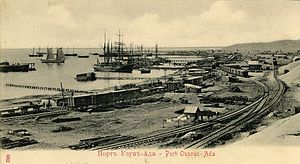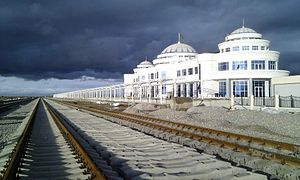Trans-Caspian railway

The Trans-Caspian Railway (also called the Central Asian Railway,
History
Construction



Construction began in 1879 of a
Economic impact
The railway permitted a massive increase in the amount of cotton exported from the region. This increased from 873,092 pudy in 1888 to 3,588,025 in 1893. Also sugar, kerosene, wood, iron and construction material were imported into the area. These rising trade figures were used by Governor-General Nikolai Rozenbakh to argue for the extension to Tashkent, while the merchant N. I. Reshetnikov offered private funds for the same purpose.[2]
Revolution and Civil War
The railway was the most important means of communication in the area, and workers on the railway became key activists during the
Both railway and workers played an important role in the Russian Civil War. Troops of the British Indian Army participated in some of the battles along the railway line. Tashkent was an important bastion for the Red Army.[5]
Under the Soviet Union
During the Soviet period and beyond, the railway was administered from Tashkent.
Route

The railway starts at the eastern shore of the Caspian Sea at
The main line continues from Turkmenabat through
See also
- Railways in Turkmenistan
References
- ^ Military power, conflict, and trade by Michael P. Gerace, Routledge, 2004 p182
- ^ Russian Colonial Society in Tashkent by Jeff Sahadeo, Indiana University Press, 2007, p120
- ^ Sahedeo, Jeff, Russian colonial Society in Tashkent, 1865-1923, Indiana University Press, 2007, p. 190
- ^ The Times, The Fighting In Trans-Caspia, 3 March 1919
- ^ Hopkirk, Peter, On Secret Service East of Constantinople, John Murray, 1994
Further reading
- )
- Annenkov, Mikhail (1881). Ахал-Техинский Оазис и пути к Индии. Санкт-Петербург.
{{cite book}}: CS1 maint: location missing publisher (link) - Dobson, George (1890). Russia's Railway Advance Into Central Asia. W. H. Allen & Co. OCLC 1097761.
